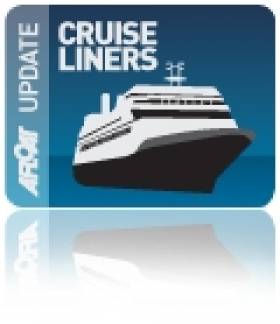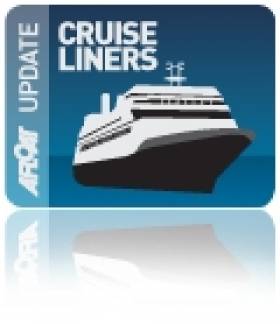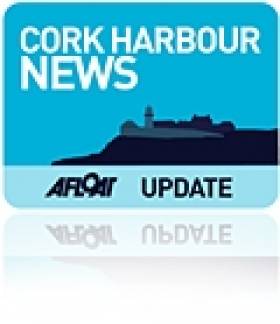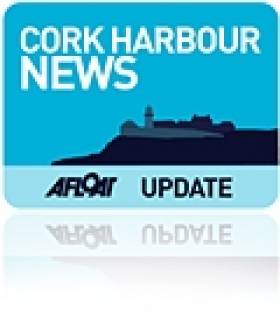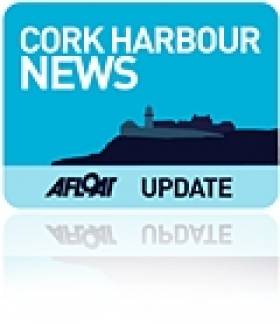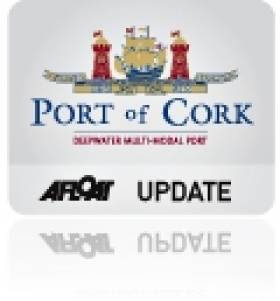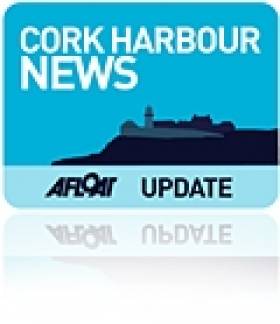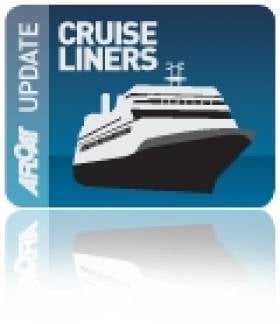Displaying items by tag: port of Cork
Frostbite 'Cruising'
This morning the 28,388 gross tonnes cruises-ship Boudicca is due to arrive into Dublin Port, writes Jehan Ashmore. The visit of the 1973-built vessel will represent the second last cruise-call of this year's cruise-season. The 900-passenger capacity Boudicca will depart later today on a 10-day cruise to include calling to Cork.
The final cruise-call scheduled for Dublin Port will once again by made by Boudicca on 20 November. On that cruise the Fred. Olsen Cruise Lines ship will be returning from Cork after an overnight passage.
Next year Dublin is to welcome 86 cruise-ships, where the largest of these vessels will berth in Alexandra Quay, located 2 kms from the city centre. Smaller vessels can dock closer to the city-centre but they have to transit the East-Link toll-road lift bridge. In addition the depth of water on the River Liffey also restricts the size of cruise-ship.
Incidentally the Boudicca will be the first caller to Dublin in 2011, with a morning arrival due on 9 April. For further information on next year's cruise-call season, a list is available online at www.dublinport.ie/not-in-menu/cruise-ship-scheduled/
Over 100,000 Cruise Passengers Visit Port of Cork in 2010
2010 proved to be another busy year for the Port of Cork with a total of 52 cruise liners calling to Cobh, Ireland's only dedicated cruise berth.
Onboard the 52 cruise liners were a total of 100, 414 passengers and crew, a record number to visit Cork.
Following the Port of Cork's investment in Cobh's dedicated cruise berth over the last five years, some of the largest liners in the world are now capable of berthing, bringing with them thousands of passengers and crew, all of whom contribute to the local economy. With a ambitious target to grow the cruise business even further, the Port of Cork are aiming to increase the number of cruise liner calls over the next five years to seventy-five.
Speaking at a recent Port of Cork cruise seminar entitled Achievement of growth in the cruise business in Cork, Captain Michael McCarthy, Port of Cork Commercial Manager said: 'We are keen to grow the business even more over the next five years. This will mean further investment of Cobh Cruise berth from the Port of Cork to handle even larger ships and to increase the number of current overnight stays.'
He continued: 'While the Port of Cork is committed to investment in this area we recognise that the region is the biggest benefactor from this business and we would therefore encourage the local authorities and organisations to support this investment.'
In a recent study carried out by UK cruise consultants, GP Wild, the on average spend per in-transit passenger is approximately €73 per day while in port. Captain McCarthy commented: 'With so many passengers arriving into Cobh and Cork, the impact that this has on the local economy is very positive.'
During the cruise seminar Captain McCarthy talked about Cork's potential as a cruise capital saying that: 'Feedback from cruise companies visiting Cork is very positive. Direct access to the quayside for passengers coupled with the accessibility of trains to Cork and the historic town of Cobh and its attractions on their doorstep, makes Cobh an attractive port of call. However tour operators and shore side attractions must all work together to offer passengers exciting full and half day tours, while also making it a memorable experience so that they may return.'
Also speaking at the Port of Cork cruise seminar was Clare Newman Port of Dover, Paul Ellerby UK Cruise Consultant and Aiden Pender Failte Ireland.
Since 1991 Port of Cork passenger and crew numbers have grown by nearly 85,000, highlighting the rapid growth of the sector which is predicated to continue. Cruise bookings for 2011 have already exceeded 2010 calls and potentially could be the busiest yet for the Port of Cork.
The 2011 Port of Cork cruise bookings list will be available at www.portofcork.ie at the end of January 2011.
'Unauthorised' Harbour Moorings to be Removed
The Port of Cork intends to remove all unauthorised or illegibly marked moorings in Cork harbour this winter and has written to harbour users about the removal which will start next month.
The Port Company recently completed a detailed survey of all moorings within Cork Harbour. A number of unauthorised and illegibly marked moorings have been identified in the course of the survey. The Port says it is the responsibility of the mooring holder to ensure that their mooring is in the correct position and is clearly marked at all times with the correct mooring number. All unauthorised or illegibly marked moorings will be removed over the coming months commencing on the 1st day of November 2010.
The Port has asked Royal Cork Yacht Club to bring the matter, affecting all harbour users, to the attention of its members according to a post on the club website.
The post also says that all boats are requested to obey the speed limits in various parts of the harbour, particularly on their way to the new pontoon in the city. Boats travelling at excessive speed make life very difficult for other harbour users, particularly the members of the rowing clubs on the river.
Hundreds Gathered for Cork Harbour Open Day
Cork Harbour Open Day proved to be a great success with hundreds of people enjoying the harbour and the free family events on offer. Throughout the day, the LE Aoife at Horgan's Quay welcomed families and children on board where they were given a tour of the ship and an insight into Navy life. The sailing race from Cobh to Blackrock, sponsored by the Port of Cork, was a huge success with over 50 boats taking part. Blackrock Castle opened the tower to the public and was busy throughout the day with people using the tower to watch the boats sail through the finish line at Blackrock.
Camden Fort in Crosshaven attracted hundreds of visitors to see the newly restored rooms and to learn more about the 'Rescue Camden' project. Also in Crosshaven the Coastal Rowing Association organised their end of season championship regatta where Passage West won all eleven races and the RNLI Station opened to the public.
'Dreamer' the fastest rigid inflatable boat (RIB) round Ireland was at the Port of Cork Marina for all to see. Built locally by Gale Force Ventures in Carrigaline and owned by current round Ireland record holder, Phillip Fitzgibbon from Co. Kerry, the 10 metre RIB can reach a speed of 65 knots.
Further events such as the World Rescue Challenge on North Custom House Quay, attracted large crowds over the whole weekend and in Cobh, the 'See You in Cobh' committee organised a crab fishing event on the promenade with over 80 children taking part.
One of the organisers of Cork Harbour Open day, Sara Dymond was thrilled with the day saying: 'The sun shone in Cork Harbour on Saturday and showed the harbour in all its glory. Cork Harbour Open Day aims to raise awareness of the different activities available for people in the harbour both on and off the water and this year we saw an exceptional turnout of people of all ages. There are endless activities to do in the Harbour and this year proved how popular the harbour is and how much people enjoy it. We hope to expand on this for next year.'
She continued: 'Thank you to all those who arranged events and helped out on the day.'
The idea for a Harbour Open Day emerged from discussions between various stakeholders involved in the development and implementation of the Integrated Strategy for the Harbour. A group comprising representatives from UCC, City and County Councils and the Port of Cork set about working together to engage users of the Harbour and to organise the Open Day.
Images from Bob Bateman on the Afloat Gallery HERE
Cobh to Blackrock Race was Scorching Success
The racing was started from the beautiful Ketch Soubrette from the Naval Service Yacht Squadron Cove S.C. First off were the slow dinghies and the white sail and classic yachts and these presented no problem to the Race Officer. However, when it came to the turn of the cruisers, with a strong flood tide they charged the line, and a general recall ensued. The Race Officer then proceeded to start the J80s before having another attempt at the cruisers Zero to Class Four. This time a Z flag was flown and anyone over the line in the final minute would have a 20% penalty applied. Happily, all went well on this occasion with a clean start and although the breeze was light and flukey all boats managed to make the finish at Blackrock Castle before the time limit. The finishing boat was a former Aran Class Lifeboat, the Samuel J and the first boat to reach the line was Jim Sheerin of Royal Cork Yacht Club in his Catamaran, narrowly beating Eddie English in the Holy Grounder from Sail Cork. In days gone by Eddie used always be first to the finish line in his yellow Hobie. Happy memories!
The event played a big part in the Port of Cork Open Day and for the first time the race had the benefit of the Port of Cork City Marina. When the boats had completed the race at Blackrock Castle they proceeded right up to the city for the prize giving and other festivities planned. All the local towns and villages in and around Cork had events planned for the Open Day and what a difference to last year when the event was completely washed out.
What a coup for Cove Sailing Club with the wonderful reinvigoration of this much loved event. One of the nice things about this is that young children were to be seen sailing with their parents and being given the opportunity to helm all types of craft from Catamarans to Cruisers. It was that kind of event and a wonderful way to get youngsters interested in sailing and fostering a love of the sport.
Photos of the event on the Afloat Gallery HERE
65–Knot RIB for Cork Harbour Open Day
Further free family events are planned to take place around the harbour as part of Cork Harbour Open Day, such as the World Rescue Challenge on North Custom House Quay, the Irish Navy's LE Aoife will be open to the public for tours of the ship on Horgan's Quay, Cobh Tourism have organised a crab fishing event along the promenade in Cobh, while ten free tickets for a tour on Spike Island are being given away by tour guide Michael Martin, see www.corkharbour.ie for more details.
In Crosshaven there will be farmers markets, coastal rowing championships, Camden Fort will be open to the public and an art exhibition by John Adams in mad Fish Restaurant, Cronin's pub. Crosshaven RNLI Station will be open to the public and the RNLI will also be carrying out free Sea Safety checks on lifejackets throughout the day at the Port of Cork City Marina. While in Cobh the annual Cobh to Blackrock sailing race will start at 12 noon from Cobh.
Blackrock Castle Observatory will be open to the public for free tours of the tower, where people will get a bird's eye view of the boats as they pass Blackrock. Spectators are encouraged to come out and watch the boats as they race up to Blackrock and continue on to the Port of Cork City Marina. Atlantic Sea Kayaking are also offering a 2 for 1 deal for kayaking on the river Lee during the day.
Aimed at embracing what Cork Harbour has to offer, the Cork Harbour Open Day aims to raise awareness of the different activities available for people in the harbour both on and off the water.
The idea for a Harbour Open Day emerged from discussions between various stakeholders involved in the development and implementation of the Integrated Strategy for the Harbour. A group comprising representatives from UCC, City and County Councils and the Port of Cork set about working together to engage users of the Harbour and to organise the Open Day.
To get involved in Cork Harbour Open Day or to organise an event on the day, please visit www.corkharbour.ie or contact Sara Dymond at [email protected] or 021-4625375.
What: Cork Harbour Open Day
When: Saturday 4th September 2009
Where: Various locations around Cork Harbour
Info: www.corkharbour.ie
Glasheen Boys School Cruise to Victory
During the summer Glasheen Boys National School were announced as the overall winners of the 2010 Port of Cork Schools Initiative. As overall winners, the 5th class boys were treated to a tour onboard MV Independence of the Seas, the largest cruise liner to visit an Irish port.
While onboard the boys were shown around the huge liner and got to see the amazing flow rider in action on the top deck, as well as the climbing wall, running track, nine hole miniature golf course, the ice skating rink and of course the Alhambra theatre. They were also taken to the exclusive helipad for a photo with the Captain of the Independence of the Seas. Here the boys got a bird's eye view of the Cobh and the lower harbour.
Over 50 schools in and around Cork were invited to take part in the Port of Cork Schools Initiative which was themed 'Cork Harbour through Your Eyes – commercial, leisure and environment – Working in Harmony'. All submitted projects were put on public display in the reception area of Customs House.
Commenting on the school projects and the trip onboard the Independence of the Seas, Captain Pat Murphy, Port of Cork Community Liaison Officer said; 'Congratulations to Glasheen Boys National Schools for their excellent submission, it is clear they went to a lot of effort creating their project and we were delighted to bring them onboard the Independence of the Seas today.'
He continued: 'The Port of Cork will run the Schools Initiative again next year and we hope to encourage even more schools around Cork to take part. This is a great way of educating school children on the history of the Port and Cork Harbour.'

Port of Cork Opens its Doors for Heritage Day
On Saturday 28th August 2010, the Port of Cork will open its doors to the public from 11am until 4pm as part of Cork Heritage Day. The spectacular rooms of Custom House will be open to the public offering visitors the opportunity to view the impressive boardroom and committee room as well as the fine collection of maritime artwork owned by the Port of Cork Company.
With the new Port of Cork City Marina in place, the Port of Cork is encouraging boat owners to use the facility for Cork Heritage Day.
Commercial Manager Michael McCarthy said; 'The Pork of Cork are delighted to open Custom House once again to the public and what better way to arrive in the city than by water. We are encouraging all boat owners if they are planning on visiting the city for Heritage Day to use the Port of Cork City Marina, which allows excellent access to all the city attractions.'
The Port of Cork City Marina is free to use during the day, however overnight charges do apply. It is advisable to pre-book a berth if planning on visiting the city by boat for Cork Heritage Day. To request a berth please visit www.portofcork.ie
Event to Showcase Cork Harbour
Cork Harbour Open Day will take place on Saturday 4th September 2010 and already there are a number of free events planned to take place around the harbour.
To name but a few, Cork City will host the World Rescue Challenge on the Port of Cork's North Custom House Quay, Cobh will host the start of the annual Cobh to Blackrock Sailing race, while in Crosshaven there will be farmers markets, rowing championships and the RNLI Station will be open to the public.
It is expected that many more events will be announced in the coming days. For a full programme please visit www.corkharbour.ie
Aimed at embracing what Cork Harbour has to offer, the Cork Harbour Open Day aims to raise awareness of the different activities available for people in the harbour both on and off the water.
The idea for a Harbour Open Day emerged from discussions between various stakeholders involved in the development and implementation of the Integrated Strategy for the Harbour. A group comprising representatives from UCC, City and County Councils and the Port of Cork set about working together to engage users of the Harbour and to organise the Open Day.
Cork Harbour is the second largest natural harbour in the world, next to Sydney Harbour, offering beautiful locations for enjoying the outdoors, dramatic coastlines, and excellent leisure facilities.
To get involved in Cork Harbour Open Day or to organise an event on the day, please visit www.corkharbour.ie or contact Sara Dymond at [email protected] or 021-4625375.
Dublin and Cork Share Cruise-Calls Bonanza
The ports of Dublin and Cork are scheduled to receive a record 139 cruiseships in total this year, bringing 180,000 visitors and crew. Many more of these cruiseships are due to visit over the next two months and stretching into late Autumn. Between €35-55m is expected to be generated into the Dublin region from high-spend cruise visitors
while a further €5m is predicted for the local economy at Cork, writes Jehan Ashmore.
A notable visitor due to grace Dublin Bay is the return of The World, albeit not strictly a cruiseship but the first custom-built time-share ship. The vessel is to dock in the capital for four-nights from 4-8 August and then sails overnight to Cobh, for two-nights from 9-11 August.
In essence, The World presents an exclusively unique lifestyle experience. Instead of passengers, there are 'residents' who live onboard. Residents of the 43,188 gross tonnes (GT) vessel don't merely occupy a cabin but own large-sized luxurously appointed private apartments that are 'home' complete with balconies.
On 9 August, Silver Cloud docks at Dublin from Oban, Scotland. Measuring 16,927 GT, the vessel may not be the largest with only 315 passengers, but is an ultra-luxury cruiseship, regarded as one of the highest standards in the cruise-sector industry.
Returning to Cork Harbour, Cobh awaits the mighty Independence of the Seas. At 154,407 tonnes, she is the biggest ever cruiseship to dock at any Irish port. With a massive 4,375 passenger capacity, attractions include rock-climbing or surfing-boarding using a special pool. The 'Independence' berths mid-afternoon on 29 August for an overnight call, departing 18.00hrs the next day.
Among smaller cruiseships, the private-motoryacht like, Island Sky of 4,000 tonnes and with 200 passengers, calls to Dublin on 11 August, and may berth upriver close to the new Samual Beckett Bridge.
Those keen on traditional ships, can look forward to the visit of Classic International Cruises Princess Danae, built in 1955. The veteran is due 16 August, and her sister, Princess Daphne is expected 2 September. Unusually the 16,000 tonnes pair were converted from general cargo-ships for a career in cruising.
New cruiseship, Costa Luminosa (92,700 GT) costing US $ 548m makes a second call to Cobh on 3 September and is operated by Costa Cruises.
This is the first time the Italian company has ventured into Irish cruising waters.
Without doubt the largest Dublin caller this season will be Emerald Princess. The giant weighs some 113,000 gross tonnes and at 288m long will certainly provide a spectacle, with lights blaring over a dozen or so decks, during a dusk departure on 14 September.
Also entering service this year, P&O Cruises 116,000 tonnes new Azura, is set to visit Dublin on 23 September and Cork the next day. The Italian built newbuild cost US $ 535m and has a capacity for 3,076 passengers.
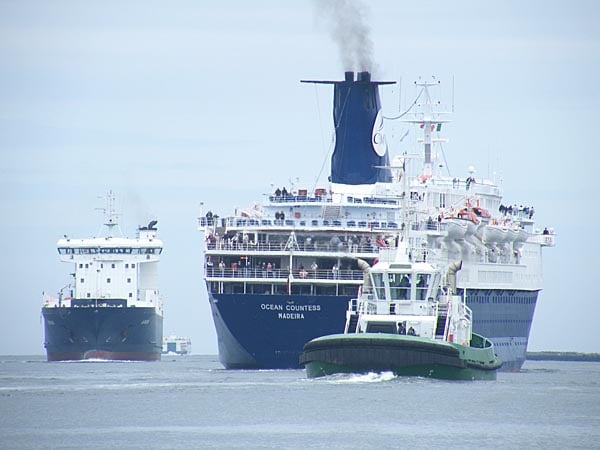
Ocean Countess departing Dublin. Photo: Jehan Ashmore/ShipSNAPS
A newcomer to Irish ports is Cruise & Maritime Voyages Ocean Countess which is making round Ireland itineraries with calls at Cobh on 13 August and 12 September. Incidently the 'Countess' was converted into a troopship for the Falkland Islands conflict in 1982.
Jewel of the Seas (90,090 GT) makes a Cobh call on 7 September and exactly a month later returns, marking the last cruise-call to Cork in 2010 while Fred Olsen's Boudicca will be Dublin's last caller on 20 November.
For further information on other visiting cruiseships, please click links:


























